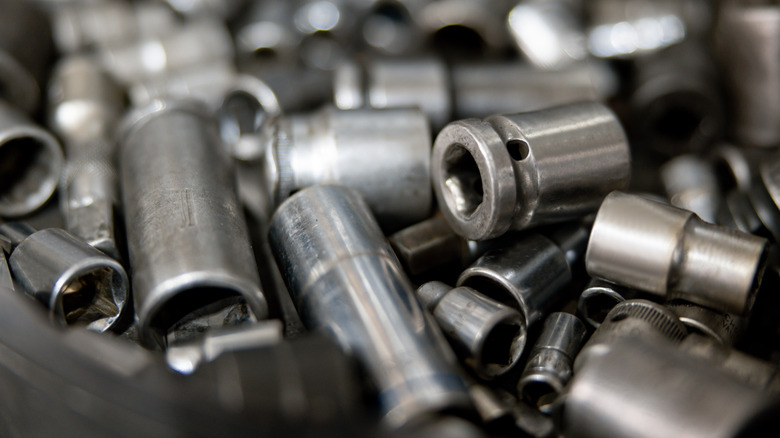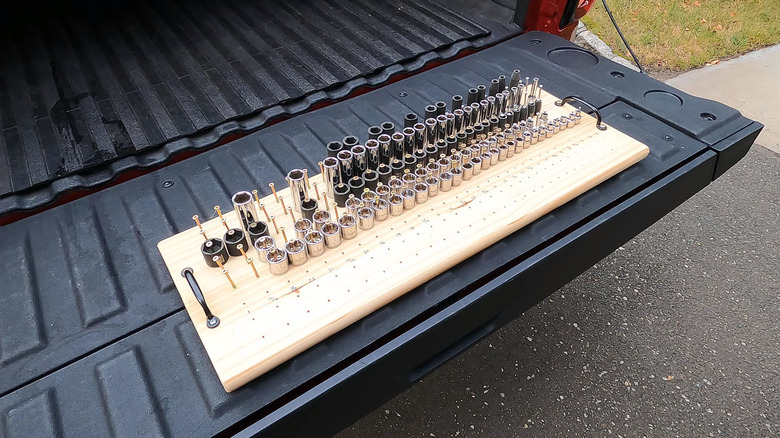Keep Small Tool Parts Neat And Tidy With This DIY Socket Organizer
The socket struggle is real. Or, as maker and Mythbuster Adam Savage put it in a YouTube video, "Every maker who has ever had to deal with sockets knows the pain of having a socket set." It's actually several different pains: never having a complete set, terrible cases that don't hold the sockets properly, and having to dig through a pile of loose sockets because you didn't put them back in the awful case last time. The solution, as usual, lies in building your own socket organizer. There are plenty of options here, and which is best for you depends on how you use it.
The key question is whether you'll need to carry the socket organizer around with you or if it will sit in your toolbox or wall within easy reach of most of your socket use. If your organizer is portable, it will need to be light enough to carry, and the sockets will need to be reasonably well-secured. Also, how stable is your socket collection? If you periodically add to it, the storage solution will need to adapt or expand to accommodate the newcomers. For a very large or comprehensive set of sockets, you might also need to account for the various types of sockets available: SAE and metric sizes, various depths of sockets, impact versus non-impact sockets, the three standard socket sizes (¼-, ⅜-, and ½-inch), hex versus 12-point sockets, and maybe others. Let's take a look at the options.
Choosing a mobile or non-mobile socket organizer
As with most things in life, if there's a decent solution to a problem, you can find it — and 10 alternatives — on YouTube. The most satisfying is probably also the least useful: the built-in, non-portable organizers. These tend to be tidier, hold less, and often include storage for ratchets, extensions, and other accessories. This includes Adam Savage's toolbox drawer organizer and others, like @EngineeredWoodworkingandDIY's YouTube version. His grid-based approach is a horizontal pegboard, and we all know how valuable and inspirational pegboard can be as a garage storage idea. He made dowels and planed them down ¹⁄₃₂ of an inch smaller than the sockets' nominal size for a good fit. These were glued to plywood inserted into the drawer, meaning you can add "make it a better actual toolbox" to the list of creative ways to repurpose an old toolbox around your home.
This non-mobile solution is great for auto mechanics building a home workshop but impractical for a handyman working all over a home or a town. The mobile versions that hold all your sockets are great for one-person workshops but less ideal when more than one person might need access to them at any given time. They can also be heavy. One of our favorites, by YouTuber @DoneRightReviews, weighs around 20 pounds, so you might want to build several instead of a single, all-in-one solution.
Building your own socket organizer
@DoneRightReviews uses screws as posts for the individual sockets, while YouTuber @PawPawsWorkWShop uses wood dowels. Dowels the same size as the sockets (¼-inch dowels for ¼-inch sockets, etc.) hold the sockets firmly, but the posts might loosen over time. It also takes more time to build an organizer that way. Both start by drawing a grid on a board (@DoneRightRerviews used a 30- by 12-inch stair tread), around 1 inch by 1 inch.
For the dowel version, you then drill holes at the intersections of your lines. You can mark the desired depth by putting a bit of painter's tape on your drill bit or using the depth stop on your drill press. The process is made much easier and more accurate by using a drill press fence to align the holes along one axis. Glue dowels cut to an appropriate length into the holes you drill. Driving screws is easier, to be sure. The screw lengths you use will be driven by the depth of the sockets you use, and the size of sockets will limit the head size you're organizing — #9 screws for ⅜-inch sockets, and #10 or even larger for ½-inch sockets. Dowels are probably a better choice if you have ¼-inch sockets or lots of small ⅜-inch sockets because the barrel narrows to the size of the target bolt. A screw or nail small enough for tiny sockets won't be sturdy enough to hold the socket in place.

